Klarstein 3MC Light Therapy Sunlight SAD Disorder Lamp Medical CE — 10000 LUX — Review
© 2014 Peter Free
13 November 2014
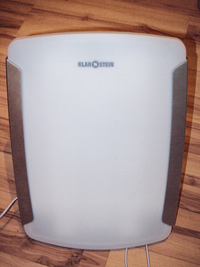
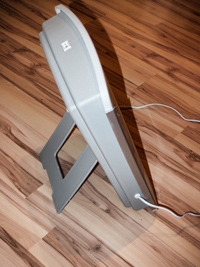
This review is predominantly intended for Americans in Germany . . .
. . . who want a 220 volt seasonal affective disorder light at a reasonable price.
The lamp works for the purpose, but not as well as the SunBox Company’s more expensive, far better built SunRay models.
Background
I’m temporarily in Germany for three years. This year’s weather has been gloomy by southwest US standards. Summer here did not even exhibit Seattle’s seasonal flirtation with sunny weather. I wanted a 220 volt seasonal affective disorder light to offset the unending dreariness.
I found the Klarstein light on Amazon.de via its affiliated seller, Elektronic-Star.
The German name for this model is:
Klarstein 3MC moderne Lichtdusche Tageslichtlampe Wellness-Leuchte Medizinische CE
This seller was tops in promptness, packaging and everything else.
If your are leery of trying to translate the Amazon website’s German
England’s Amazon carries the same thing from Elektronic-Star-UK.
And HiFi-Tower in Kent sells the Klarstein online, but at a higher price. The listing appends some useful pictures.
My impressions
The Klarstein light is commendably lightweight, but at the price of being plastic.
I opened it up to see what was inside. Four clips that hold the front and back of the unit together require some finicky adjustments, during reassembly to get them into the proper places to sandwich all the layers. The very small metal screws tighten into plastic holes. Not a durable design.
The bulbs inside have no brand name.
Note
German Amazon buyer, Andi (Andreas Morgta), posted a favorable review, here, which shows the opened unit.
As you can see in the pictures, the lamp is designed to shine upward at an angle. That is the reverse of the SunRay, which is designed to shine down, more like the sun overhead.
The SunRay also works better if you want to read while using it. You can put a book between its legs and read in bright, reflected light. In contrast, the Klarstein shines into your face.
I also found that the German box puts out less light than the SunRay at equivalent distances.
An aside on color temperature and allegedly “full spectrum” bulbs
The Klarstein uses two 36 watt, allegedly “daylight, full spectrum” 2G-11 base bulbs. The instruction manual says it puts out 10,000 lux at 15 centimeters (6 inches).
I noticed that the manual does not list the color temperature of the bulbs. That is a bit unusual. Top of the line seasonal affective disorder lamp manufacturers commonly incorporate bulbs that operate above the commonly available 3,500 to 4,100 kelvin (color temperature) range.
Incidentally, the 2G-11 designation refers only to the bulb base, meaning the design of the way the bulb connects to a lamp’s electrical socket. To find a 2G-11 full spectrum bulb, you have to look for the “full spectrum” designation, as well as the 2G-11 description.
Before obsessing about color spectrum, remind yourself that no one really knows:
(a) whether a midday-simulating spectrum is actually required to treat seasonal affective disorder
or
(b) whether variously differing combinations of emitted light work identically across a wide range of people — I doubt that they do.
Some years ago, a few manufacturers thought that adding blue light to full spectrum output would improve therapeutic results. I tried one of these lamps and found that it did not work for me. The blue component was “sad” in itself.
Full spectrum “noon” light reportedly very roughly falls into the 5,000 to 5,500 kelvin (color temperature) range. Be aware that some manufacturers call their warmer bulbs (approximately 3,500 to 4,100 kelvin) “full spectrum”, when they are arguably not.
Supposed “noon” light (on the Earth’s surface) varies by latitude, season, dust, humidity and cloud cover. Wikipedia lists the color temperature of the sun, measured above Earth’s atmosphere, at 5,900 kelvin.
A concisely excellent explanation of color temperatures and how they are often verbally described by bulb manufactures is here.
A perhaps better measurement of a bulb’s emitted wavelengths (in the laboratory) is its Color Rendering Index (CRI), but very few manufacturers refer to that standard.
Bulbs emitting below about 5,000 kelvin (according to the manufacturer’s estimate) do not work well for me.
The Klarstein manual helpfully lists the specifications for a Philips replacement bulb, apparently because finding a 36 watt full spectrum 2G-11 bulb is more challenging than one might think:
Philips Master PL-L 36W/865/4p
Philips lists this bulb at 6,500 kelvin, which means that it is bluer than those in the 5,000 to 5,500 range.
Light duration and distance from it
The Klarstein instruction manual makes the following recommendations for distance (from the lamp) and therapeutic duration times:
60 cm (24 in) — 2 hours
30 cm (12 in) — 1 hour
20 cm (8 in) — 30 minutes
These distances are shorter than the SunRay’s. The Klarstein lamp did not work very well sitting on my desk adjacent to my computer display. It was too far away and angled too far off my visual axis.
There is something odd, too, about the time distinction between 30 and 60 centimeters. Illumination falls off (inversely) with the square of increasing distance. One would think that doubling the distance from 30 to 60 centimeters would require a quadrupling of sitting time. Evidentally, Klarstein thinks that light exposure has some physiological thresholds that are not accounted for by these simple mathematics.
Making the Klarstein lamp work (for me) — using (prohibitively expensive) equipment that I already had on hand
The setup looks like this:
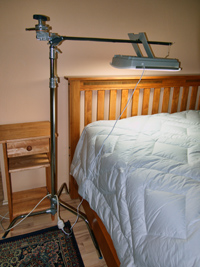
I used an Avenger A2033FKIT 10.75' C-Stand Grip Arm Kit to suspend the lamp. The kit includes c-stand legs, two risers, a 40 inch arm, and a 2.5 inch grip head that attaches the arm to the stand.
I slipped a 700x28-32c bicycle tube onto the arm. The rubber gives the Klarstein’s foldable leg more grip on the chromed arm. Without it, the slippery leg plastic lets the lamp slide to one or the other sides of the leg’s inside cutout. This may actually not really be a problem. I just wanted to see whether I could get the lamp to stay where I initially thought that I wanted it.
I suspended the top of the Klarstein from the c-stand arm by tying string to a wall picture hook and slipping the end of the hook into the mounting recess on the back of the lamp.
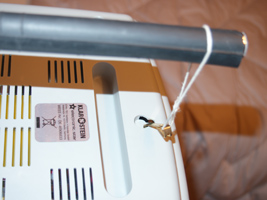
Note — 27 January 2015
Relatively soon after trying the bicycle tube idea, I abandoned it. The rubber made sliding the lamp back and forth on the c-stand arm (as described in the following section) too difficult.
Adjustments
Loosening the stand’s top riser allows one to raise and lower the arm (with the lamp still suspended), which makes adjusting one’s distance from the light easy.
If you leave the Avenger grip head slightly loose on the stand post, you can swing the arm (with the light suspended from it) horizontally in any direction you want.
For example, when I’m done using the lamp, I slide it from the end of the arm toward the stand’s riser. Rotating the arm’s end toward the wall at the head of the bed gets the lamp out of the way.
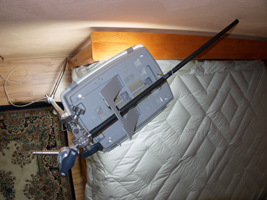
Admittedly, the overall contraption looks like a piece of hospital equipment.
The moral? — The Klarstein is a comparatively inexpensive seasonal disorder light that works well enough
If you want a sturdier, brighter light — take a look at SunBox Company’s products. These come in both 110 and 220 volt models. I have owned the 110 volt version of the original SunRay for 21 years.
 PeteFree.com
PeteFree.com